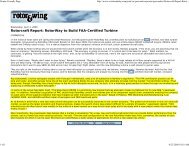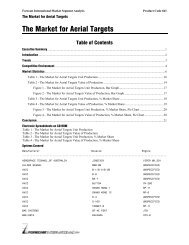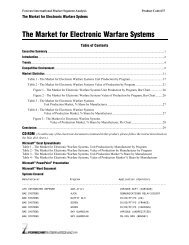The Market for Medium/Heavy Military Rotorcraft - Forecast ...
The Market for Medium/Heavy Military Rotorcraft - Forecast ...
The Market for Medium/Heavy Military Rotorcraft - Forecast ...
Create successful ePaper yourself
Turn your PDF publications into a flip-book with our unique Google optimized e-Paper software.
Page 6 <strong>Rotorcraft</strong> <strong>Forecast</strong><br />
Sikorsky UH-60/S-70 Black Hawk<br />
Background. In 1968, the U.S. Army launched<br />
studies of a new troop-carrying helicopter to replace the<br />
Bell UH-1. Study contracts firmed up the requirement<br />
<strong>for</strong> a twin-engine helicopter able to carry 11 combatready<br />
troops plus a crew of three. This helicopter was<br />
known as the Utility Tactical Transport Aircraft System<br />
(UTTAS).<br />
Parallel development at the Army's Aviation Materiel<br />
Laboratories at Fort Eustis, Virginia, resulted in the<br />
design of a new turboshaft engine, <strong>for</strong> which Requests<br />
<strong>for</strong> Quotations (RFQ) went out in mid-1971. In<br />
December of that year, General Electric's GE12<br />
powerplant was selected <strong>for</strong> the UTTAS. <strong>The</strong> T700<br />
production engine was derived from the GE12.<br />
December 2010<br />
UH-60A Selected <strong>for</strong> UTTAS<br />
Airframe Requests <strong>for</strong> Proposals (RFP) went out to nine<br />
companies in early 1972 and, in August of that year,<br />
Sikorsky and Boeing Vertol were selected as finalists.<br />
Sikorsky flew the first prototype YUH-60A in October<br />
1974, and completed two more flight test units shortly<br />
thereafter. <strong>The</strong> first unit was delivered to the Army in<br />
March 1976. In December 1976, Sikorsky's UH-60A<br />
was declared the UTTAS winning design. <strong>The</strong><br />
prototype machines accumulated 650 flight test hours.<br />
<strong>The</strong> UH-60A had a long fuselage that presented a low,<br />
squat profile. <strong>The</strong> four blades of the main rotor were<br />
pressurized, utilized structural integrity indicators, and<br />
featured tips that were swept back 20 degrees. Leading<br />
edges each carried electrically heated de-icing mats.<br />
<strong>The</strong> rotor head incorporated bifilar vibration absorbers<br />
and elastomeric rotor hub bearings that required no<br />
lubrication, thereby reducing hub maintenance by 60<br />
percent. <strong>The</strong> Black Hawk was originally slated to have<br />
Program Review<br />
Related News<br />
a fluidic stability augmentation system but was<br />
eventually fitted with an electronic unit instead. <strong>The</strong> tail<br />
rotor, which was mounted at the top of a high vertical<br />
fin, was canted 20 degrees off the vertical. This<br />
placement created about 181 kilograms (400 lb) of<br />
vertical thrust and allowed <strong>for</strong> greater center-of-gravity<br />
travel. An all-flying stabilator automatically sensed<br />
airspeed changes, and its position ranged from 39<br />
degrees down at a hover to horizontal at cruise speeds.<br />
RTM322 Engine. Westland fitted an S-70C with a<br />
pair of 2,100-shp Rolls-Royce Turbomeca RTM322-01<br />
turboshafts, and flew the aircraft in June 1986.<br />
UH-60/RTM322 certification was obtained in late 1987.<br />
<strong>The</strong> U.S. Army evaluated the RTM322 against GE's<br />
uprated T700-GE-701C be<strong>for</strong>e selecting the GE engine<br />
in early 1988 to power Black Hawks delivered from<br />
1989 onward.<br />
Korean Coproduction. In 1990, Sikorsky and Korean<br />
Air announced U.S. government approval of licensed<br />
coproduction of the Black Hawk in South Korea. <strong>The</strong><br />
helicopter was built <strong>for</strong> the South Korean military under<br />
the UH-60P designation. <strong>The</strong> UH-60P is a standard<br />
U.S. Army UH-60L with minor changes tailored to meet<br />
South Korean government requirements. Korean Air<br />
built over 100 Black Hawks.<br />
No WS-70 Orders<br />
Westland Licensed Program. A Sikorsky/Fiat<br />
acquisition of a nearly 16 percent share in Westland<br />
involved licensed production of the UH-60 by the U.K.<br />
manufacturer. In September 1986, Westland officially<br />
launched the WS-70 program, followed by a first flight<br />
in April 1987. However, Westland never gained a<br />
single order <strong>for</strong> the WS-70.<br />
200th UH/HH-60M Delivered to U.S. Army – Sikorsky delivered the 200th UH/HH-60M Black Hawk<br />
helicopter to the U.S. Army in July 2010. "<strong>The</strong> UH-60M aircraft have been per<strong>for</strong>ming phenomenally well in<br />
theater, supporting our troops and providing them with the latest technology <strong>for</strong> the mission," said Doug Shidler,<br />
Sikorsky vice president <strong>for</strong> army programs. "<strong>The</strong> feedback from the U.S. Army has been extremely positive, as<br />
more M models are introduced into the fleet." (Sikorsky, 7/10)<br />
First Flight of S-70i – <strong>The</strong> initial S-70i International Black Hawk completed its first flight in July 2010. Aircraft<br />
0001 was built at Sikorsky subsidiary PZL Mielec in Poland. <strong>The</strong> flight took place at the Sikorsky Development<br />
Flight Center in Florida.<br />
Production of the S-70i involves the use of a global supply chain. <strong>The</strong> helicopter is the first Black Hawk to ever be<br />
assembled in Europe. "As Sikorsky Aircraft continues to grow internationally, we recognize the significance of this











